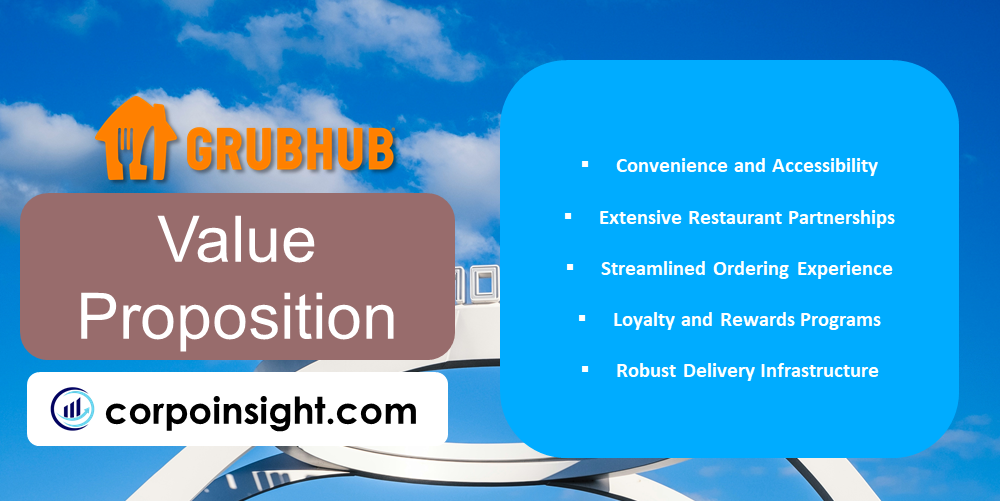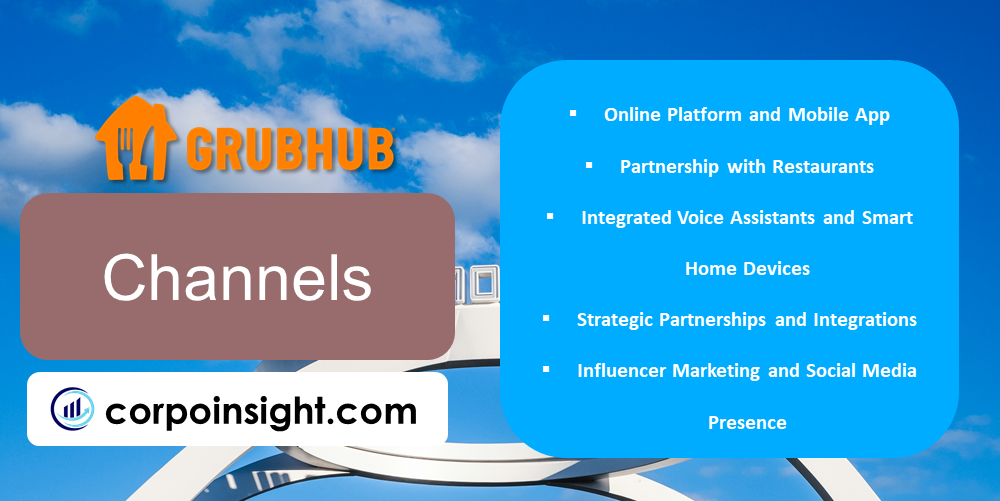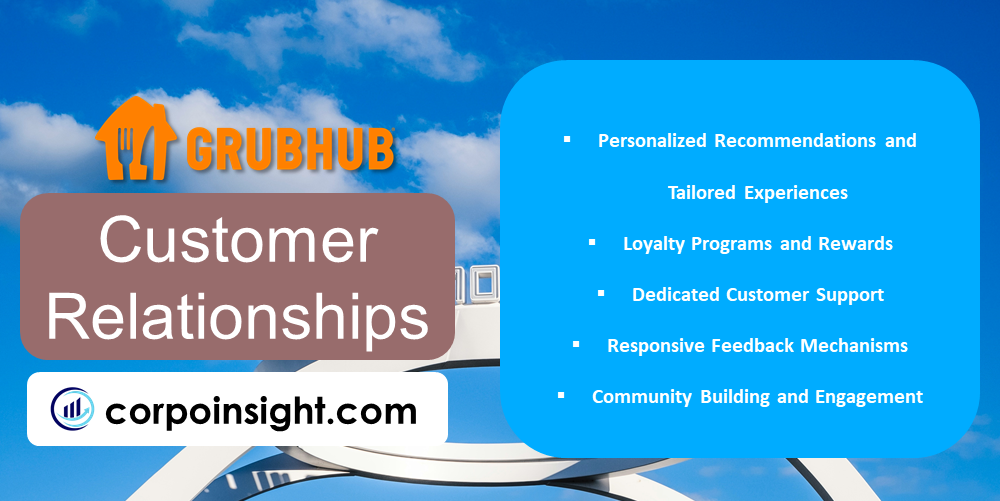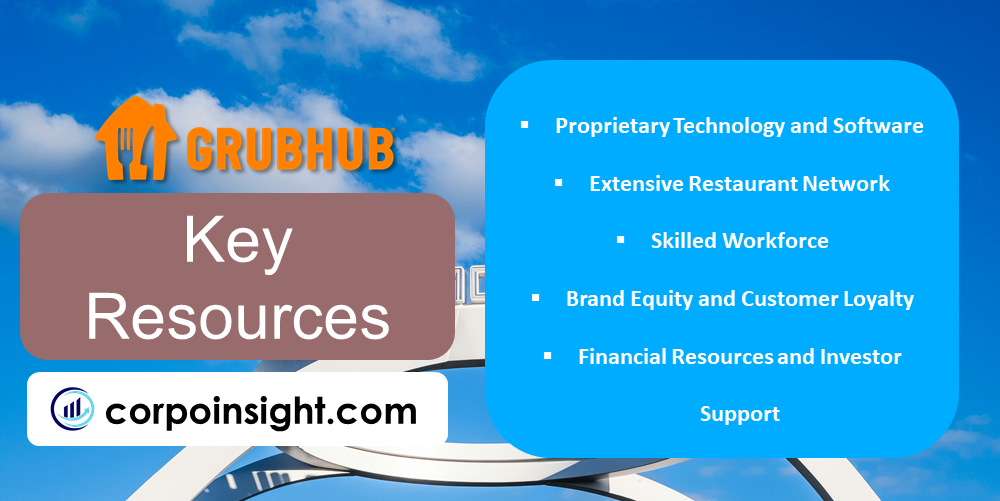Grubhub Business Model Canvas 2024
While revolutionizing the food delivery landscape with its seamless online platform, Grubhub has emerged as the go-to solution for those craving convenience and culinary diversity, seamlessly bridging the gap between hungry patrons and a vast array of dining establishments. In this Grubhub Business Model Canvas, we will learn its customer segments, value proposition, revenue streams, channels, customer relationships, key activities, key resources, key partners, and cost structure.
Interesting fact!
The company has a dedicated team of “restaurant whisperers” whose job is to visit eateries and provide feedback on their online presence and customer experience.
Grubhub Competitors
Uber Eats | DoorDash | Postmates | Caviar | Seamless | Eat24 | Delivery.com | ChowNow | BeyondMenu | Ritual
Customer Segments – Grubhub Business Model Canvas

1. Urban Professionals: With their fast-paced lifestyles and limited time for cooking, urban professionals represent a significant portion of Grubhub’s customer base, as the platform offers a convenient solution for ordering meals from a wide array of restaurants, catering to their diverse culinary preferences and dietary needs.
2. Families: Grubhub’s user-friendly interface and extensive restaurant selection have made it a go-to choice for families seeking a hassle-free way to enjoy a variety of cuisines without the hassle of cooking, particularly during weeknights or special occasions when time is scarce.
3. College Students and Young Adults: Grubhub’s affordable options and seamless online ordering process have resonated strongly with college students and young adults, who often prioritize convenience and cost-effectiveness while navigating busy schedules and limited budgets.
4. Businesses and Corporate Clients: Recognizing the demand for efficient meal solutions in the corporate world, Grubhub has carved out a niche by offering dedicated corporate accounts and group ordering services, catering to businesses seeking to provide their employees with convenient dining options during meetings or events.
5. Hospitality and Tourism Industry: As the hospitality and tourism sectors continue to thrive, Grubhub has positioned itself as a valuable partner, enabling hotels, resorts, and other travel-related businesses to offer their guests a diverse range of dining options through its platform, enhancing overall customer satisfaction and convenience.
Value Proposition – Grubhub Business Model Canvas

1. Convenience and Accessibility: By offering a user-friendly online platform and mobile app, Grubhub has revolutionized the way consumers access a vast array of dining options, allowing them to effortlessly browse menus, place orders, and receive their meals with minimal effort, catering to the demands of a fast-paced, on-the-go lifestyle.
2. Extensive Restaurant Partnerships: Grubhub’s extensive network of partnered restaurants, spanning various cuisines and price points, provides consumers with an unparalleled choice, ensuring that they can satisfy their diverse culinary cravings and dietary preferences with just a few taps on their devices.
3. Streamlined Ordering Experience: Through its intuitive interface, customizable order settings, and secure payment options, Grubhub has streamlined the entire ordering process, eliminating the hassle and potential errors associated with traditional phone or in-person orders, thereby enhancing customer satisfaction and loyalty.
4. Loyalty and Rewards Programs: By implementing loyalty and rewards programs, Grubhub incentivizes repeat business and fosters a sense of community among its customer base, rewarding their loyalty with exclusive discounts, promotions, and personalized recommendations based on their preferences and order history.
5. Robust Delivery Infrastructure: Grubhub’s extensive delivery network, powered by a fleet of dedicated drivers and advanced logistics technologies, ensures that customers receive their orders promptly and efficiently, contributing to an overall positive dining experience and reinforcing the platform’s value proposition of convenience and reliability.
Revenue Streams – Grubhub Business Model Canvas

1. Delivery Fees and Service Charges: Grubhub generates a significant portion of its revenue through the delivery fees and service charges imposed on customers for each order, with these fees varying based on factors such as the restaurant’s location, order size, and peak demand periods, enabling the company to monetize its delivery infrastructure effectively.
2. Commission from Restaurant Partners: By partnering with a vast network of restaurants, Grubhub collects a commission on each order placed through its platform, with the commission rate typically ranging from 10% to 30% of the total order value, providing a steady revenue stream that scales with the platform’s growth and popularity.
3. Advertising and Promotional Opportunities: Grubhub offers restaurants and other businesses the opportunity to advertise on its platform, generating revenue through sponsored listings, banner ads, and targeted promotions, allowing these partners to reach a highly engaged audience of potential customers and increase their visibility on the platform.
4. Subscription-Based Services: Recognizing the demand for premium features and enhanced ordering experiences, Grubhub has introduced subscription-based services, such as Grubhub+ and Grubhub for Work, which provide customers and businesses with additional benefits, including unlimited free delivery, exclusive discounts, and streamlined ordering processes for a recurring fee.
5. Data Analytics and Insights: By leveraging the vast amount of data generated through its platform, Grubhub has created opportunities for monetizing its insights and analytics capabilities, offering valuable consumer behavior data and market intelligence to restaurant partners and other businesses, enabling them to make informed decisions and optimize their strategies.
Channels – Grubhub Business Model Canvas

1. Online Platform and Mobile App: Grubhub’s primary channels are its user-friendly online platform and mobile app, which serve as the gateway for customers to browse menus, place orders, and track deliveries, providing a seamless and convenient ordering experience that caters to the demands of modern consumers.
2. Partnership with Restaurants: Grubhub’s extensive network of partnered restaurants serves as a crucial channel, enabling the company to offer a diverse array of dining options and reach a broader customer base by leveraging the popularity and reputation of these establishments across various cuisines and price points.
3. Integrated Voice Assistants and Smart Home Devices: Recognizing the growing adoption of voice-enabled technologies, Grubhub has integrated its services with popular voice assistants, such as Amazon’s Alexa and Google Assistant, as well as smart home devices, allowing customers to place orders and access the platform’s features through hands-free voice commands, further enhancing convenience and accessibility.
4. Strategic Partnerships and Integrations: Grubhub has forged strategic partnerships and integrations with various companies and platforms, including social media giants, entertainment providers, and travel services, enabling customers to access its services seamlessly through these third-party channels and expanding its reach to new potential markets.
5. Influencer Marketing and Social Media Presence: Recognizing the power of social media and influencer marketing, Grubhub has established a strong presence on various platforms, leveraging influencers and content creators to promote its services, share engaging content, and interact with its audience, fostering brand loyalty and attracting new customers.
Customer Relationships – Grubhub Business Model Canvas

1. Personalized Recommendations and Tailored Experiences: By leveraging user data and advanced algorithms, Grubhub provides personalized recommendations and tailored experiences for its customers, suggesting restaurants and menu items based on their preferences, dietary restrictions, and previous order history, fostering a sense of connection and enhancing customer satisfaction.
2. Loyalty Programs and Rewards: Grubhub has implemented robust loyalty programs, such as Grubhub+ and Grubhub Perks, which offer exclusive discounts, free deliveries, and special promotions to frequent users, incentivizing repeat business and cultivating long-term customer relationships based on value and appreciation for their patronage.
3. Dedicated Customer Support: Recognizing the importance of prompt and effective customer service, Grubhub has invested in dedicated customer support channels, including live chat, phone assistance, and social media support, ensuring that customers can promptly address any issues or concerns, fostering trust and confidence in the platform.
4. Responsive Feedback Mechanisms: Grubhub actively solicits customer feedback through post-order surveys, ratings, and review systems, demonstrating its commitment to continuous improvement and responsiveness to customer needs, which in turn strengthens the relationship and fosters a sense of valued partnership between the company and its users.
5. Community Building and Engagement: Through social media campaigns, interactive content, and community-focused initiatives, Grubhub has cultivated a loyal following of customers who actively engage with the brand, share their experiences, and participate in discussions, creating a sense of belonging and fostering a strong emotional connection with the platform.
Key Activities – Grubhub Business Model Canvas

1. Platform Development and Maintenance: Grubhub’s core activity revolves around the continuous development, optimization, and maintenance of its online platform and mobile applications, ensuring a seamless and user-friendly experience for customers to browse menus, place orders, and track deliveries, while constantly updating features and functionalities to stay ahead of the curve.
2. Restaurant Partnerships and Onboarding: A critical activity for Grubhub is the establishment and management of partnerships with a vast network of restaurants, encompassing the onboarding process, menu integration, training, and ongoing support, ensuring a diverse and appetizing selection of dining options for customers across various cuisines and price points.
3. Logistics and Delivery Operations: Grubhub’s success hinges on its efficient logistics and delivery operations, which involve intricate coordination of delivery personnel, route optimization, real-time tracking, and adherence to stringent quality standards, ensuring that orders are fulfilled promptly and accurately, maintaining customer satisfaction and reinforcing the platform’s value proposition of convenience.
4. Marketing and Customer Acquisition: Grubhub invests significant resources into marketing and customer acquisition activities, leveraging various channels such as digital advertising, social media campaigns, influencer partnerships, and strategic collaborations, to expand its customer base, driving brand awareness, and fostering customer loyalty.
5. Data Analytics and Insights Generation: Grubhub’s vast repository of customer data and transaction history enables it to engage in sophisticated data analytics and insights generation activities, providing valuable information to restaurant partners, optimizing operations, and informing strategic decision-making processes, ultimately enhancing the overall customer experience and driving business growth.
Key Resources – Grubhub Business Model Canvas

1. Proprietary Technology and Software: Grubhub’s success heavily relies on its proprietary technology and software platforms, which encompass the online ordering system, mobile applications, logistics management tools, and data analytics capabilities, enabling seamless operations, efficient order fulfillment, and valuable insights generation, forming the backbone of the company’s competitive advantage.
2. Extensive Restaurant Network: One of Grubhub’s most valuable resources is its extensive network of partnered restaurants, spanning various cuisines, price points, and locations, providing customers with an unparalleled selection and enabling the company to cater to diverse preferences while maintaining a strong market presence across multiple regions.
3. Skilled Workforce: Grubhub’s ability to maintain its leadership position in the food delivery industry is heavily dependent on its skilled workforce, including software engineers, data analysts, logistics experts, customer service representatives, and dedicated delivery personnel, whose collective expertise and commitment drive innovation, operational efficiency, and exceptional customer experiences.
4. Brand Equity and Customer Loyalty: Grubhub has cultivated a strong brand equity and customer loyalty over the years, becoming a household name synonymous with convenience and quality food delivery, enabling the company to leverage its reputation, maintain a loyal customer base, and attract new users through positive word-of-mouth and brand recognition.
5. Financial Resources and Investor Support: Grubhub’s ability to sustain its growth and invest in strategic initiatives is underpinned by its robust financial resources and investor support, providing the necessary capital for technological advancements, marketing campaigns, operational expansions, and strategic acquisitions, enabling the company to maintain its competitive edge and market leadership.
Key Partners – Grubhub Business Model Canvas

1. Restaurant Partners: Grubhub’s extensive network of partnered restaurants forms the backbone of its business model, enabling the company to offer a diverse range of dining options to customers while providing these establishments with a platform to reach a broader audience, streamline their operations, and increase their revenue streams through online ordering and delivery.
2. Delivery Service Providers: To ensure efficient and timely order fulfillment, Grubhub collaborates with various delivery service providers, including third-party logistics companies and independent contractors, leveraging their expertise in last-mile delivery logistics and ensuring a seamless experience for customers, particularly during periods of high demand.
3. Payment Processing Partners: Grubhub has established strategic partnerships with leading payment processing companies, facilitating secure and convenient payment options for customers, including credit card processing, mobile wallets, and alternative payment methods, enhancing the overall ordering experience and reducing friction in the transaction process.
4. Technology and Software Providers: To maintain a cutting-edge platform and enhance its technological capabilities, Grubhub collaborates with various technology and software providers, ranging from cloud computing services to artificial intelligence and data analytics solutions, enabling the company to stay ahead of the curve and provide innovative features to its customers and restaurant partners.
5. Marketing and Advertising Partners: Recognizing the importance of effective marketing and brand awareness, Grubhub has forged strategic partnerships with various advertising agencies, influencers, and media platforms, enabling the company to reach its target audience through targeted campaigns, sponsored content, and strategic collaborations, ultimately driving customer acquisition and retention.
Cost Structure – Grubhub Business Model Canvas

1. Technology and Platform Development Costs: A significant portion of Grubhub’s costs is dedicated to the continuous development, maintenance, and enhancement of its proprietary technology platforms, including the online ordering system, mobile applications, logistics management tools, and data analytics capabilities, ensuring a seamless and efficient user experience while staying ahead of the competition.
2. Marketing and Customer Acquisition Expenses: With intense competition in the food delivery market, Grubhub invests substantial resources in marketing and customer acquisition activities, such as digital advertising campaigns, influencer partnerships, and strategic collaborations, aiming to expand its customer base, drive brand awareness, and foster customer loyalty, which constitutes a significant recurring cost.
3. Logistics and Delivery Operations Costs: As a core component of its business model, Grubhub incurs significant costs related to its logistics and delivery operations, including expenses associated with third-party delivery service providers, vehicle maintenance, fuel, and insurance, as well as investments in route optimization technologies and real-time tracking systems.
4. Restaurant Partner Commissions and Fees: Grubhub’s revenue-sharing model with partnered restaurants requires the company to pay commissions and fees to these establishments for each order placed through its platform, with the commission rates typically ranging from 10% to 30% of the total order value, representing a substantial ongoing cost.
5. Customer Service and Support Costs: To maintain high levels of customer satisfaction and address inquiries and concerns promptly, Grubhub allocates resources towards its customer service and support operations, including staffing costs for dedicated support teams, training expenses, and investments in advanced customer relationship management (CRM) systems.
Summary of Grubhub Business Model Canvas

Conclusion on Grubhub Business Model Canvas
Grubhub’s business model canvas demonstrates its strategic approach to revolutionizing the food delivery industry. By leveraging proprietary technology, an extensive restaurant network, robust logistics operations, and strategic partnerships, Grubhub has established itself as a leader in providing convenient and diverse dining experiences. However, intense competition and the need for continuous innovation necessitate ongoing investments in key areas to maintain its competitive edge and drive long-term growth.

This is Ahsanul Haque, someone very passionate about digital marketing, SEO, and Data Analytics and founder of the Analytics Empire and currently pursuing my major in marketing at Bangladesh University of Professionals.






